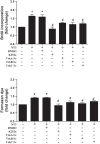Neurotrophin 3 upregulates proliferation and collagen production in human aortic valve interstitial cells: a potential role in aortic valve sclerosis
- PMID: 28356268
- PMCID: PMC5494589
- DOI: 10.1152/ajpcell.00292.2016
Neurotrophin 3 upregulates proliferation and collagen production in human aortic valve interstitial cells: a potential role in aortic valve sclerosis
Abstract
Calcific aortic valve disease (CAVD) is a leading cardiovascular disorder in the elderly. Diseased aortic valves are characterized by sclerosis (fibrosis) and nodular calcification. Sclerosis, an early pathological change, is caused by aortic valve interstitial cell (AVIC) proliferation and overproduction of extracellular matrix (ECM) proteins. However, the mechanism of aortic valve sclerosis remains unclear. Recently, we observed that diseased human aortic valves overexpress growth factor neurotrophin 3 (NT3). In the present study, we tested the hypothesis that NT3 is a profibrogenic factor to human AVICs. AVICs isolated from normal human aortic valves were cultured in M199 growth medium and treated with recombinant human NT3 (0.10 µg/ml). An exposure to NT3 induced AVIC proliferation, upregulated the production of collagen and matrix metalloproteinase (MMP), and augmented collagen deposition. These changes were abolished by inhibition of the Trk receptors. NT3 induced Akt phosphorylation and increased cyclin D1 protein levels in a Trk receptor-dependent fashion. Inhibition of Akt abrogated the effect of NT3 on cyclin D1 production. Furthermore, inhibition of either Akt or cyclin D1 suppressed NT3-induced cellular proliferation and MMP-9 and collagen production, as well as collagen deposition. Thus, NT3 upregulates cellular proliferation, ECM protein production, and collagen deposition in human AVICs. It exerts these effects through the Trk-Akt-cyclin D1 cascade. NT3 is a profibrogenic mediator in human aortic valve, and overproduction of NT3 by aortic valve tissue may contribute to the mechanism of valvular sclerosis.
Keywords: AVIC; Akt; Trk; fibrogenic response; neurotrophin 3.
Copyright © 2017 the American Physiological Society.
Figures








Similar articles
-
TLR4 Stimulation Promotes Human AVIC Fibrogenic Activity through Upregulation of Neurotrophin 3 Production.Int J Mol Sci. 2020 Feb 14;21(4):1276. doi: 10.3390/ijms21041276. Int J Mol Sci. 2020. PMID: 32074942 Free PMC article.
-
Complement Upregulates Runx-2 to Induce Profibrogenic Change in Aortic Valve Interstitial Cells.Ann Thorac Surg. 2021 Dec;112(6):1962-1972. doi: 10.1016/j.athoracsur.2020.12.058. Epub 2021 Feb 3. Ann Thorac Surg. 2021. PMID: 33545156 Free PMC article.
-
Over-expression of neurotrophin 3 in human aortic valves affected by calcific disease induces the osteogenic responses via the Trk-Akt pathway.Biochim Biophys Acta. 2015 Sep;1852(9):1940-9. doi: 10.1016/j.bbadis.2015.06.021. Epub 2015 Jun 27. Biochim Biophys Acta. 2015. PMID: 26122822
-
Extracellular Matrix in Calcific Aortic Valve Disease: Architecture, Dynamic and Perspectives.Int J Mol Sci. 2021 Jan 18;22(2):913. doi: 10.3390/ijms22020913. Int J Mol Sci. 2021. PMID: 33477599 Free PMC article. Review.
-
Calcific Aortic Valve Disease: Part 2-Morphomechanical Abnormalities, Gene Reexpression, and Gender Effects on Ventricular Hypertrophy and Its Reversibility.J Cardiovasc Transl Res. 2016 Aug;9(4):374-99. doi: 10.1007/s12265-016-9695-z. Epub 2016 May 16. J Cardiovasc Transl Res. 2016. PMID: 27184804 Free PMC article. Review.
Cited by
-
TLR4 Stimulation Promotes Human AVIC Fibrogenic Activity through Upregulation of Neurotrophin 3 Production.Int J Mol Sci. 2020 Feb 14;21(4):1276. doi: 10.3390/ijms21041276. Int J Mol Sci. 2020. PMID: 32074942 Free PMC article.
-
Silk fibroin hydrogel with recombinant silk fibroin/NT3 protein enhances wound healing by promoting type III collagen synthesis and hair follicle regeneration in skin injury.Mater Today Bio. 2025 Jun 9;33:101957. doi: 10.1016/j.mtbio.2025.101957. eCollection 2025 Aug. Mater Today Bio. 2025. PMID: 40575657 Free PMC article.
-
The role of neurotrophins in psychopathology and cardiovascular diseases: psychosomatic connections.J Neural Transm (Vienna). 2019 Mar;126(3):265-278. doi: 10.1007/s00702-019-01973-6. Epub 2019 Feb 14. J Neural Transm (Vienna). 2019. PMID: 30767081 Free PMC article. Review.
-
Cathepsin D elevates the fibrocalcific activity in human aortic valve cells through the ERK1/2-Sox9 pathway.Front Cardiovasc Med. 2024 Sep 24;11:1410862. doi: 10.3389/fcvm.2024.1410862. eCollection 2024. Front Cardiovasc Med. 2024. PMID: 39380629 Free PMC article.
-
Simulated microgravity significantly altered metabolism in epidermal stem cells.In Vitro Cell Dev Biol Anim. 2020 Mar;56(3):200-212. doi: 10.1007/s11626-020-00435-8. Epub 2020 Mar 20. In Vitro Cell Dev Biol Anim. 2020. PMID: 32198676 Free PMC article.
References
-
- Cimini M, Boughner DR, Ronald JA, Aldington L, Rogers KA. Development of aortic valve sclerosis in a rabbit model of atherosclerosis: an immunohistochemical and histological study. J Heart Valve Dis 14: 365–375, 2005. - PubMed
MeSH terms
Substances
Supplementary concepts
Grants and funding
LinkOut - more resources
Full Text Sources
Other Literature Sources
Research Materials
Miscellaneous

